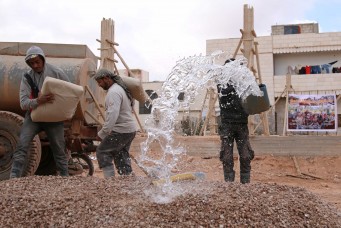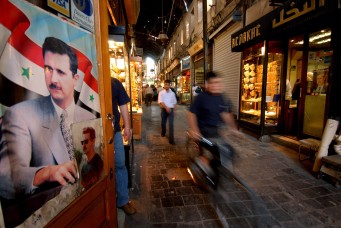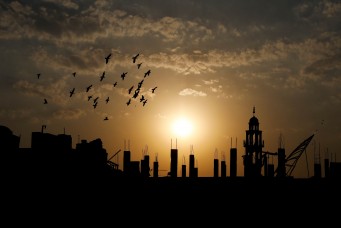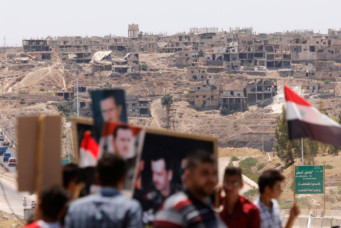Is Reconstruction Syria’s Next Battleground?
The Syrian regime is turning to reconstruction to boost legitimacy and consolidate control, a process that also benefits its external allies.
In the bloody and protracted Syrian conflict, the humanitarian space has been heavily constrained. Different warring parties grant or withhold humanitarian access to advance their military strategies and political objectives. The Syrian regime has relied on the distribution of international aid to reward loyalty, punish dissent, further civilian dependency on it, and undermine the creation of alternative political orders. Similarly, war-driven logics now appear to be playing a prominent role in the discussions on how to begin rebuilding the country, with the regime relying on reconstruction to boost legitimacy and consolidate control.
Reconstruction will constitute an enormous task; over the past six years Syria has suffered cumulative GDP losses around $226 billion, seen half of its population displaced by conflict, and witnessed substantial damage to its civilian infrastructure. A 2017 World Bank report estimates that up to 27 percent of houses in the assessed urban centers have been either destroyed or damaged, and total reconstruction costs are estimated between $200 and $350 billion.
But reconstruction is also an opportunity to reconfigure the urban landscape of Syria’s most important cities and, in doing so, to reshape or consolidate political and power dynamics. Rehabilitating houses, services, and infrastructure is a highly political process that offers domestic actors and external powers a chance to increase their leverage and influence and shape the future of Syria.
In the case of Syria, key questions related to reconstruction pertain to which cities or neighborhoods are prioritized in the rebuilding process: how and for whom they are rebuilt, and who gets to decide and implement the renewal projects. These issues are important in all post-conflict reconstruction processes, but they are especially relevant in the Syrian context, where rebuilding has begun separately from a national process of political settlement or societal reconciliation.
Conventional wisdom on post-conflict recovery and reconstruction postulates that physical rebuilding, economic recovery, political reforms, and societal reconciliation should all proceed in tandem to shift a country from war to peace. But, in Syria , there is a risk that the bulk of the reconstruction and economic recovery will continue to proceed in isolation from negotiations to end hostilities. Under these circumstances, reconstruction can easily become a tool to consolidate war gains and existing power dynamics, preventing or complicating—rather than supporting—a war-to-peace transition.
The main projects aimed at rebuilding residential areas of war-torn Syria over the past year—including in the Damascus, Homs and Aleppometropolitan areas—have already seen some of these dynamics linked to politicization of reconstructions. A first readily observable trend linked to reconstruction is how rebuilding is proving an effective system for the government to reward and strengthen local allies, consolidating power even as it devolves the authority for rebuilding locally. This is achieved in two main ways: first, by directly awarding reconstruction tenders to local authorities, government-backed NGOs, private actors, and ad-hoc public-private local partnerships, all according to a logic that rewards political loyalty to the regime. Second, by continuing to demand all international actors work only with government-approved local partners, the central government has found a way to effectively reconcile international donors’ call for “localization” while preserving de facto power and control.
The government has also been pushing to redevelop informal settlements, including Basateen al-Razi in the Damascus area, where a multi-million urban redevelopment project aims to build a large residential area intended to house over 60,000 residents and replace the previous settlement. But the modern character of the project—including high-rise buildings—is not without potential problems; indeed its implementation inevitably includes the demolition and dramatic reconfiguration of the previous urban landscape. The redevelopment can in turn have a dire impact on its previous residents, especially as many of them have been displaced by the conflict. Clearing these areas for redevelopment raises fears in the displaced population that their displacement and dispossession could be made permanent, by both physically destroying their homes and de facto reallocating their property rights.
Basenteen al-Razi is not exceptional. It is one of many informal settlements—which simultaneously constitute some of the poorest and more severely war-damaged areas in cities like Homs, Damascus or Aleppo, among others—intended to be rebuilt and redeveloped. What is more, in instances like Basateen al-Razi in the Damascus area or the Jouret al-Shayahneighborhood in Homs, the areas at the center of redevelopment projectsare also former opposition strongholds, adding to the fears that dramatically reconfiguring these areas could serve as a power consolidation and population control tool, with significant impact on the civilian population, and especially on the 6.3 million IDPs nationwide. In these cases, reconstruction risks heightening, rather than lessening, societal conflict, while increasing the vulnerability of segments of the population that are already at risk. In other words, reconstruction policies have a concrete political impact, as well as the potential to create or consolidate forms of marginalization within Syria. As such, they are also a significant protection issue.
Another way for the Syrian government to maximize the political returns on the reconstruction process is to ensure that the external actors that end up helping foot the reconstruction bill or playing a prominent role in the reconstruction business will continue to afford the Syrian government freedom to maneuver, allowing it to consolidate its own advantage in the conflict. This is why the Syrian government has repeatedly stated that China, India, Iran, and Russia are welcome to play a role in rebuilding Syria, as they are perceived as less likely to condition aid on political reforms, as the European Union has suggested. The more the Syrian government is able to rely on these key allies, particularly Iran and Russia, the more it will be able to move forward with a reconstruction process that is divorced from issues pertaining to political transition and reform.
The relation between reconstruction, governance, and power is not lost on any of the external actors in Syria. Even as they negotiate de-escalation and ceasefire arrangements, external powers will likely also seek to cement spheres of influence in Syria through reconstruction. For example, Turkey is investing in rebuilding war-damaged infrastructure in al-Bab, outside of Aleppo, and has even announced it plans to build an entirely new suburb nearby. While Turkey hopes this will drive out extremist groups and encourage many of the refugees it is hosting across the border in Gaziantep to return to Syria, these efforts are as much about present-day stabilization as about establishing future political influence.
In turn, as reconstruction moves forward, former Assad opponents like the United States and the EU will face a dilemma between investing in “technical” reconstruction—relinquishing any semblance of putting conditions on aid and de facto rewarding the regime and its consolidation of power on the ground—or refusing to participate in the reconstruction process all together, risking losing even more influence.
The international development sector as a whole faces the same predicament when thinking about how to operate in the complex Syrian context. Indeed, while the need for reconstruction and recovery is undeniable, the ongoing violence and militarization mean the Syrian government can continue to use reconstruction to consolidate control and solidify wartime alliances. Yet if the physical rebuilding of the country’s infrastructure continues to occur separately from talks to reach a political settlement and to repair Syria’s devastated social fabric, it will negatively impact already vulnerable sectors within Syrian society and further delay any discussion on how to move beyond war and conflict.
This article is reprinted with permission of Sada. It can be accessed online here.
Benedetta Berti is a Robert A. Fox Senior Fellow at the Foreign Policy Research Institute (FPRI) and a TED Senior Fellow. On Twitter: @BenedettaBertiW.
Subscribe to Our Newsletter






